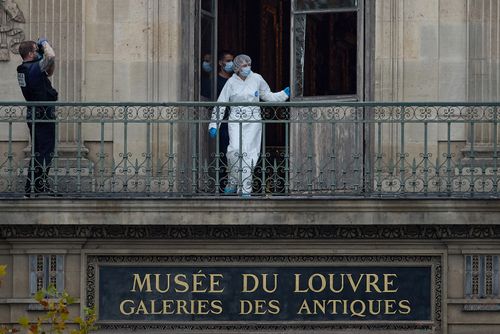Share this @internewscast.com
During a French Senate hearing, Louvre director Laurence des Cars revealed that the museum is suffering from a critical lack of security cameras surrounding its premises. This shortcoming, among other “weaknesses,” was highlighted by a theft that occurred on Sunday.

Facing intense scrutiny following a heist that tarnished France’s international reputation, des Cars informed a Senate committee that she offered her resignation. However, the culture minister declined to accept it.
“We are facing a significant failure at the Louvre, and I fully acknowledge my share of the responsibility,” she stated.
The perpetrators managed to stealthily enter and exit, stealing eight items from France’s Crown Jewels collection at the world’s most popular museum. This cultural blow is being likened by some to the 2019 blaze at Notre-Dame Cathedral.
The heist, which took place just steps away from the Mona Lisa and is valued at €88 million ($157.5 million), has heightened scrutiny of President Emmanuel Macron, Des Cars, and other officials.
This incident follows months after museum staff staged a strike, protesting persistent understaffing and inadequate security measures, with too few personnel monitoring an extensive number of exhibits.
Crowds bunched at the barriers as they were being removed on Wednesday, a coda to frantic forensic work and staff briefings that had taken place. Inside, the scene of the crime â the Apollo Gallery housing the Crown Diamonds â stayed sealed, a folding screen obscuring the doorway at the gallery’s rotunda entrance.

Three days on, the jewels remain missing and the thieves are still at large â and reactions are divided.
“For a place like the Louvre, it’s unfathomable,” said Amanda Lee, 36, an art teacher from Chicago.
“I heard it took under four minutes. How is that possible here, with no police in sight?”
“We told the kids it’s a history lesson. The Apollo Room is shut, but we saw the masterpieces,” said Claire Martin, 41, a French lawyer from Versailles visiting with her two children during a school holiday.
“We came for the art,” she said. “The police can deal with the thieves.”

France acknowledges failings
Then came the getaway on motorbikes through central Paris. Alarms had gone off, drawing agents to the gallery and forcing the intruders to bolt.
As it reopened, the Louvre declined questions from The Associated Press to detail any reinforced protocols. It said no uniformed police were posted in the corridors. With school holidays swelling demand, the day was fully booked and access limited.
“I didn’t notice extra security â guards as always, and no police inside. It felt like a normal day,” said Tomás Ãlvarez, 29, a software engineer from Madrid.

The thieves made away with a total of eight objects, including a sapphire diadem, necklace and single earring from a set linked to 19th-century queens Marie-Amélie and Hortense.
They also made off with an emerald necklace and earrings tied to Empress Marie-Louise, Napoleon Bonaparte’s second wife, as well as a reliquary brooch. Empress Eugénie’s diamond diadem and her large corsage-bow brooch â an imperial ensemble of rare craftsmanship â were also part of the loot.
One piece â Eugénie’s emerald-set imperial crown, with more than 1300 diamonds â was later found outside the museum, damaged but recoverable.

Fears the jewels will be destroyed
Prosecutor Laure Beccuau valued the haul at about â¬88 million, a “spectacular” figure that still fails to capture the works’ historical weight.
Beccuau said expert analyses are under way; four people have been identified as present at the scene, and roughly 100 investigators are mapping the crew and any accomplices.
The heist has intensified scrutiny of the Louvre’s security.
Culture Minister Rachida Dati drew fire on Tuesday after telling lawmakers there had been no security failings.

Questions about Louvre’s security overhaul
All this comes after Macron announced new measures in January for the Louvre â complete with a new command post and expanded camera grid that the culture ministry says is being rolled out.
It also raises hard questions, including whether Sunday’s breach is tied to staffing levels, and how uniformly the upgrades in the overhaul are being applied.
“It’s a scandal of planning,” said Luca Romano, 52, a civil engineer from Milan visiting Paris with his wife.
“If you can plant a freight lift at a palace and no one stops you, that’s a system failure.”

Protection for headline works is airtight â the Mona Lisa is behind bulletproof glass in a climate-controlled case â yet the break-in exposed seams elsewhere in a 33,000-object labyrinth. For many French, the contrast is a public embarrassment at the landmark.
It touches a raw nerve: the issue of swelling crowds and overstretched staff.
In June, a staff walkout over overcrowding and chronic understaffing delayed opening. Unions argue that mass tourism leaves too few eyes on too many rooms and creates pressure points where construction zones, freight access and visitor flows intersect.
On Wednesday, the Louvre’s other star attractions â from the Venus de Milo to the Winged Victory of Samothrace â were open again. But the cordoned-off vitrines in the Apollo Room, guarded and empty, told a different story: one of a breach measured not just in minutes and euros, but in the fragility of a nation’s patrimony.















